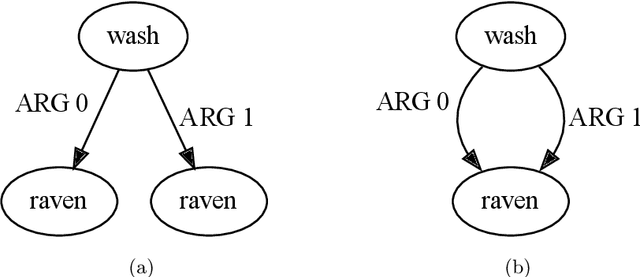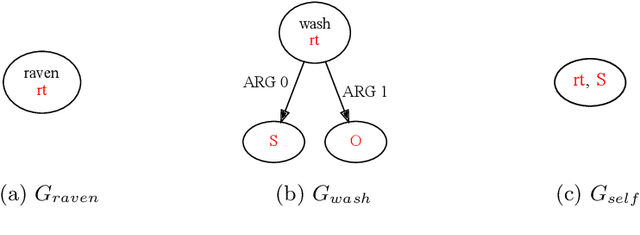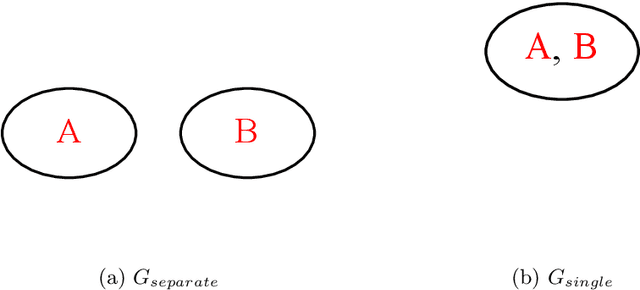Jonas Groschwitz
Scope-enhanced Compositional Semantic Parsing for DRT
Jul 02, 2024Abstract:Discourse Representation Theory (DRT) distinguishes itself from other semantic representation frameworks by its ability to model complex semantic and discourse phenomena through structural nesting and variable binding. While seq2seq models hold the state of the art on DRT parsing, their accuracy degrades with the complexity of the sentence, and they sometimes struggle to produce well-formed DRT representations. We introduce the AMS parser, a compositional, neurosymbolic semantic parser for DRT. It rests on a novel mechanism for predicting quantifier scope. We show that the AMS parser reliably produces well-formed outputs and performs well on DRT parsing, especially on complex sentences.
AMR Parsing is Far from Solved: GrAPES, the Granular AMR Parsing Evaluation Suite
Dec 06, 2023Abstract:We present the Granular AMR Parsing Evaluation Suite (GrAPES), a challenge set for Abstract Meaning Representation (AMR) parsing with accompanying evaluation metrics. AMR parsers now obtain high scores on the standard AMR evaluation metric Smatch, close to or even above reported inter-annotator agreement. But that does not mean that AMR parsing is solved; in fact, human evaluation in previous work indicates that current parsers still quite frequently make errors on node labels or graph structure that substantially distort sentence meaning. Here, we provide an evaluation suite that tests AMR parsers on a range of phenomena of practical, technical, and linguistic interest. Our 36 categories range from seen and unseen labels, to structural generalization, to coreference. GrAPES reveals in depth the abilities and shortcomings of current AMR parsers.
Learning compositional structures for semantic graph parsing
Jun 08, 2021



Abstract:AM dependency parsing is a method for neural semantic graph parsing that exploits the principle of compositionality. While AM dependency parsers have been shown to be fast and accurate across several graphbanks, they require explicit annotations of the compositional tree structures for training. In the past, these were obtained using complex graphbank-specific heuristics written by experts. Here we show how they can instead be trained directly on the graphs with a neural latent-variable model, drastically reducing the amount and complexity of manual heuristics. We demonstrate that our model picks up on several linguistic phenomena on its own and achieves comparable accuracy to supervised training, greatly facilitating the use of AM dependency parsing for new sembanks.
Fast semantic parsing with well-typedness guarantees
Oct 06, 2020



Abstract:AM dependency parsing is a linguistically principled method for neural semantic parsing with high accuracy across multiple graphbanks. It relies on a type system that models semantic valency but makes existing parsers slow. We describe an A* parser and a transition-based parser for AM dependency parsing which guarantee well-typedness and improve parsing speed by up to 3 orders of magnitude, while maintaining or improving accuracy.
Graphs with Multiple Sources per Vertex
Jun 19, 2020



Abstract:Several attempts have been made at constructing Abstract Meaning Representations (AMRs) compositionally, and recently the idea of using s-graphs with the HR-algebra (Koller, 2015) has been simplified to reduce the number of options when parsing (Groschwitz et al., 2017). This apply-modify algebra (AM-algebra) is a linguistically plausible graph algebra with two classes of operations, both of rank two: the apply operation is used to combine a predicate with its argument; the modify operation is used to modify a predicate. While the AM-algebra correctly handles relative clauses and complex cases of coordination, it cannot parse reflexive sentences like: "The raven washes herself." To facilitate processing of such reflexive sentences, this paper proposes to change the definition of s-graphs underlying the AM-algebra to allow vertices with multiple sources, and additionally proposes an adaption to the type system of the algebra to correctly handle such vertices.
Normalizing Compositional Structures Across Graphbanks
Apr 30, 2020



Abstract:The emergence of a variety of graph-based meaning representations (MRs) has sparked an important conversation about how to adequately represent semantic structure. These MRs exhibit structural differences that reflect different theoretical and design considerations, presenting challenges to uniform linguistic analysis and cross-framework semantic parsing. Here, we ask the question of which design differences between MRs are meaningful and semantically-rooted, and which are superficial. We present a methodology for normalizing discrepancies between MRs at the compositional level (Lindemann et al., 2019), finding that we can normalize the majority of divergent phenomena using linguistically-grounded rules. Our work significantly increases the match in compositional structure between MRs and improves multi-task learning (MTL) in a low-resource setting, demonstrating the usefulness of careful MR design analysis and comparison.
Compositional Semantic Parsing Across Graphbanks
Jul 13, 2019



Abstract:Most semantic parsers that map sentences to graph-based meaning representations are hand-designed for specific graphbanks. We present a compositional neural semantic parser which achieves, for the first time, competitive accuracies across a diverse range of graphbanks. Incorporating BERT embeddings and multi-task learning improves the accuracy further, setting new states of the art on DM, PAS, PSD, AMR 2015 and EDS.
AMR Dependency Parsing with a Typed Semantic Algebra
May 29, 2018



Abstract:We present a semantic parser for Abstract Meaning Representations which learns to parse strings into tree representations of the compositional structure of an AMR graph. This allows us to use standard neural techniques for supertagging and dependency tree parsing, constrained by a linguistically principled type system. We present two approximative decoding algorithms, which achieve state-of-the-art accuracy and outperform strong baselines.
 Add to Chrome
Add to Chrome Add to Firefox
Add to Firefox Add to Edge
Add to Edge